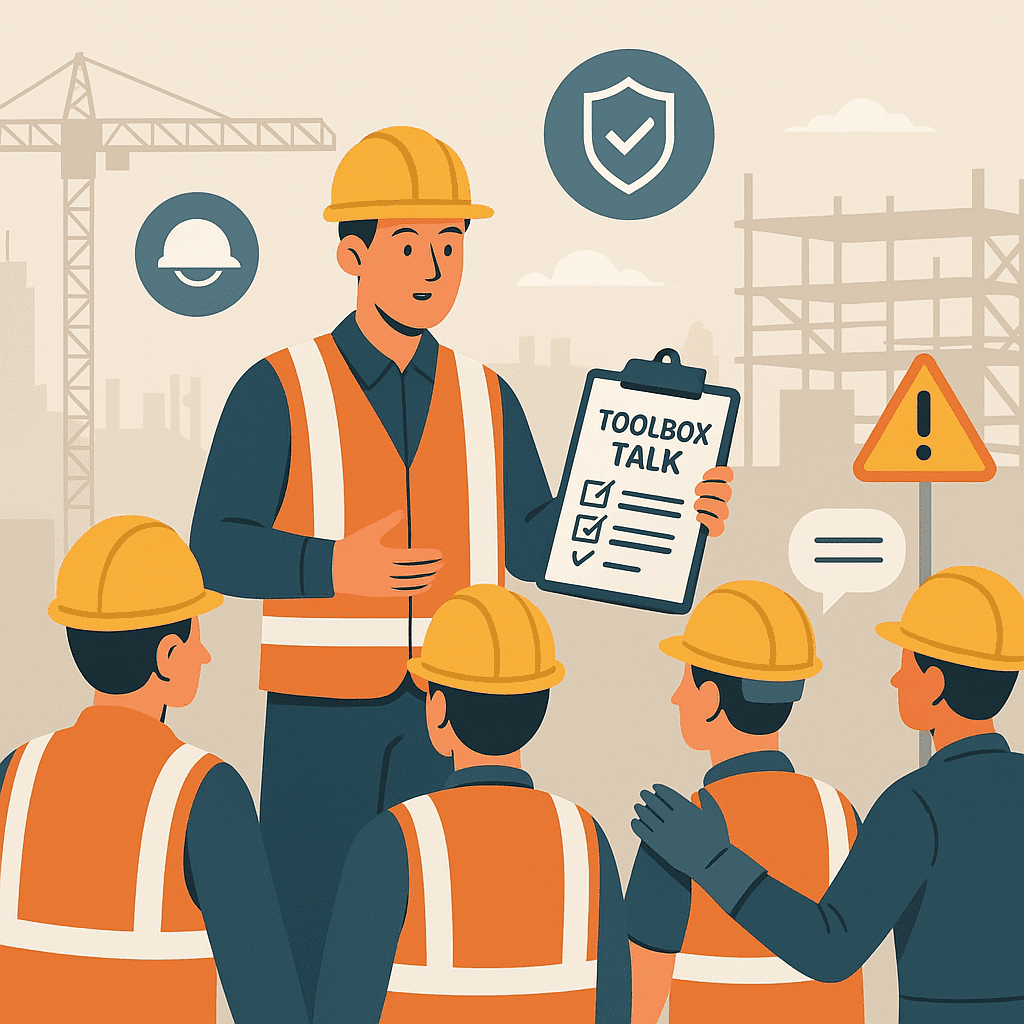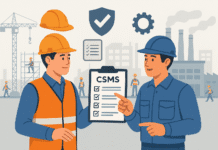
Toolbox Talk Procedure and Best Practices
In every workplace — from construction sites to factories — safety communication is essential for preventing accidents and building awareness among workers. One of the most effective tools for this purpose is the Toolbox Talk (TBT).
A well-structured Toolbox Talk ensures that all workers are informed about specific hazards, safe work procedures, and daily precautions before starting their tasks.
Despite being short and simple, toolbox talks have a powerful impact on workplace safety culture when conducted properly.
In this guide, you’ll learn:
- What a toolbox talk is and its purpose
- Step-by-step procedure to conduct an effective TBT
- Roles and responsibilities of supervisors and safety officers
- Common mistakes and how to avoid them
- Best practices and example topics
- Free Toolbox Talk Checklist Template
What is a Toolbox Talk?
A Toolbox Talk (TBT), also known as a Safety Talk or Pre-Task Talk, is a short safety meeting conducted at the job site before work begins.
Definition
“A Toolbox Talk is a brief, focused discussion that highlights the safety aspects, hazards, and control measures related to a specific job or activity.”
The goal is to ensure everyone understands the risks involved in the day’s work and the safety precautions they must follow.
Purpose of a Toolbox Talk
The main purpose of a toolbox talk is to promote proactive safety awareness and prevent incidents before work starts.
Key Objectives:
- Communicate hazards and control measures for the day’s tasks.
- Ensure everyone is aware of site-specific risks.
- Encourage participation and feedback from workers.
- Reinforce safety procedures and company policies.
- Promote teamwork and responsibility in maintaining a safe workplace.
When and Where Should Toolbox Talks Be Conducted?
Toolbox talks should be:
- Conducted before starting work (daily or before each shift).
- Held at or near the worksite where activities will take place.
- Delivered in clear, simple language understood by all workers.
Duration: Typically 10 to 15 minutes — short, interactive, and focused.
Tip: Avoid long, lecture-style sessions. Keep it conversational and relevant.
Step-by-Step Toolbox Talk Procedure
Let’s look at how to conduct an effective Toolbox Talk from start to finish.
Step 1: Select a Relevant Topic
Choose a topic that is directly related to the work planned for the day.
Example Topics:
- Working at Heights
- Electrical Safety
- Manual Handling
- Fire Prevention
- Excavation Safety
- PPE Use and Maintenance
Tip: Rotate topics based on site activities and seasonal hazards (e.g., heat stress, monsoon safety).
Step 2: Prepare the Content
Before the talk, the safety officer or supervisor should:
- Review the day’s work plan and associated risks.
- Identify key safety messages.
- Gather relevant materials (PPE samples, equipment, visuals).
- Keep a Toolbox Talk Register or attendance sheet ready.
Tip: Use simple visuals or demonstrations to improve understanding.
Step 3: Gather the Workers
Call all team members — including contractors, subcontractors, and visitors (if applicable).
- Ensure everyone can see and hear clearly.
- Avoid noisy or congested areas.
- Maintain a friendly and engaging environment.
Step 4: Deliver the Talk
The speaker (usually a supervisor or safety officer) should:
Start with a greeting and purpose
“Good morning everyone. Today we’ll discuss safe work practices for working at height…”
Explain the task and associated hazards
“We’ll be erecting scaffolding near the south wall. Hazards include falling objects, unguarded edges, and unstable platforms.”
Describe control measures
“Ensure scaffolds are tagged, use full-body harnesses, and never overload platforms.”
Encourage participation
Ask workers questions:
“Can anyone tell me what to check before using a harness?”
Conclude with reminders
“Remember, safety is everyone’s responsibility. Report any unsafe condition immediately.”
Record attendance and topic discussed.
Step 5: Encourage Interaction and Feedback
The best toolbox talks are two-way discussions, not monologues.
Encourage workers to share:
- Previous experiences or incidents.
- Suggestions for safer work methods.
- Questions about unclear procedures.
Tip: Reward active participation — it motivates others.
Step 6: Record and File Documentation
After the talk:
- Record details (date, topic, speaker, attendees).
- Keep a copy in the Toolbox Talk Register.
- Share summaries with management if needed.
Sample Record Format:
| Date | Topic | Conducted By | Location | Participants | Remarks |
|---|---|---|---|---|---|
| 11 Oct 2025 | Fire Safety | Safety Officer | Site A | 25 | Active discussion, good feedback |
Tip: Use digital apps or Excel trackers for easy recordkeeping.
Example Toolbox Talk Flow
Introduction – State the purpose and importance.
Activity Overview – Describe the job for the day.
Hazards Identification – Discuss what can go wrong.
Control Measures – Explain preventive actions.
Roles and Responsibilities – Clarify who does what.
Emergency Procedures – Remind of nearest exits and contact points.
Questions and Feedback – Encourage interaction.
Closing and Attendance – Summarize and record participation.
Example Toolbox Talk Script (Working at Height)
Introduction:
“Good morning team. Today’s work involves scaffolding and painting at height. Falls are one of the biggest causes of serious injuries on site.”
Hazards:
“We may face risks like unguarded edges, falling tools, or unstable scaffolds.”
Controls:
“Ensure scaffolds are tagged green, use harnesses tied to lifelines, and don’t stand on guardrails.”
Emergency:
“In case of fall, alert the supervisor and rescue team immediately. Don’t move the injured person.”
Conclusion:
“Remember — no work at height is safe without proper fall protection. Let’s stay alert and look out for one another.”
Responsibilities in Toolbox Talks
| Role | Responsibilities |
|---|---|
| Safety Officer | Prepare topics, guide supervisors, maintain records |
| Supervisor | Conduct talks daily, ensure participation |
| Workers | Attend, listen, and share feedback |
| HSE Manager | Monitor effectiveness, audit TBT records |
| Project Manager | Ensure time allocation and resource support |
Tip: Make toolbox talks part of your daily pre-start routine.
Benefits of Conducting Regular Toolbox Talks
Increases awareness about daily job hazards.
Reinforces safe work practices.
Promotes open communication between management and workers.
Builds trust and teamwork.
Reduces accidents and near-misses.
Improves overall safety culture on site.
Tip: Consistency is key — daily 10-minute talks are more effective than weekly 1-hour sessions.
Common Mistakes During Toolbox Talks
- Talking too long — Workers lose attention after 15 minutes.
- Reading directly from notes — Makes it boring.
- Irrelevant topics — Workers tune out.
- Lack of visuals or examples.
- No interaction.
- Not recording attendance or topic.
- Ignoring worker feedback.
Tip: Keep it practical, visual, and relatable to daily tasks.
Toolbox Talk Frequency
| Work Type | Recommended Frequency |
|---|---|
| Construction | Daily or before each shift |
| Maintenance / Plant | Weekly or before high-risk jobs |
| Office / Low Risk | Monthly |
| New Activity / Task | Before starting work |
| After Incident / Near-Miss | Immediately (as refresher) |
Tip: Always conduct a special toolbox talk after any incident or new procedure implementation.
Toolbox Talk Checklist
| Item | Yes / No |
|---|---|
| Topic relevant to ongoing activities | |
| Workers gathered at safe, quiet area | |
| Speaker prepared with examples | |
| Hazards and control measures discussed | |
| Worker participation encouraged | |
| Emergency procedures reminded | |
| Attendance recorded and filed |
Toolbox Talk Topics for Construction
Here are some popular topics you can rotate through your daily talks:
- PPE Use and Maintenance
- Housekeeping and Waste Management
- Scaffolding and Working at Heights
- Fire Safety and Hot Work
- Manual Material Handling
- Electrical Safety
- Confined Space Entry
- Excavation and Trenching
- Hazard Communication (HAZCOM)
- Emergency Evacuation Procedures
Tip: Repeat high-risk topics like height, electrical, and lifting frequently.
Evaluating Toolbox Talk Effectiveness
Evaluate toolbox talk effectiveness using Key Performance Indicators (KPIs):
| Indicator | Description |
|---|---|
| Attendance Rate | % of workers attending TBTs |
| Participation Rate | Number of active responses / total attendees |
| Incident Trend | Reduction in incidents after TBT implementation |
| Audit Findings | Closure rate of safety observations |
| Feedback Quality | Worker engagement and suggestion rate |
Tip: Use periodic surveys or quizzes to measure retention.
Best Practices for Effective Toolbox Talks
- Keep it short and focused (10–15 mins).
- Conduct at the actual worksite for realism.
- Use clear, local language understood by all.
- Include demonstrations or visuals.
- Stand in a circle to promote participation.
- Record attendance every time.
- Link talks to recent incidents or near-misses.
- Plan weekly TBT schedules in advance.
- Encourage feedback and continuous improvement.
- Integrate toolbox talks with Permit-to-Work and HIRA processes.
Tip: Recognize and reward workers who actively contribute to safety talks.
Internal Links
- Contractor Safety Management System (CSMS)
- 5 Levels of Risk Control (Hierarchy of Controls) Explained
- Safety Walkthrough vs Safety Audit
- Common Mistakes in HIRA and How to Avoid Them
- Fire Risk Assessment in the Workplace – Complete Guide
External References
Conclusion
A Toolbox Talk is one of the simplest yet most effective tools for maintaining daily safety awareness.
When done correctly, it builds trust, reinforces procedures, and ensures every worker starts the day informed and alert.
“A 10-minute talk can prevent a lifetime of regret.”
So, make toolbox talks a daily habit, not a compliance task. Engage your team, share real stories, and always end with the question —
“Are we ready to work safely today?”






















